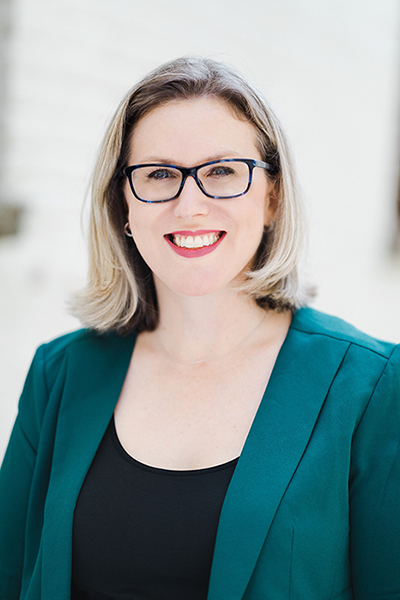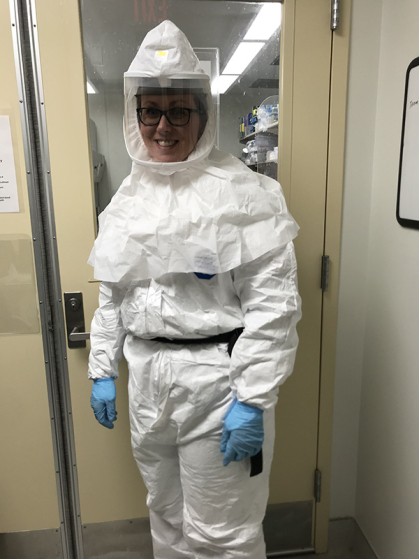Securing Harmful Viruses Is a Calling for Rutgers Biosafety Officer

Most people, if asked by the boss to secure a facility stocked with vials of tuberculosis, would find a new job.
Jessica McCormick-Ell found her life’s calling.
She accepted the challenge and became — while still in her early 20s — the biosafety manager for the first level 3 biohazard research laboratory at what is now Rutgers New Jersey Medical School. She left the industry to get her Ph.D. in microbiology and molecular genetics, but she gladly returned shortly after receiving her degree in 2010.
She has been the Rutgers University Biosafety Officer ever since.
“I knew from the work I did getting my Ph.D. that I didn’t want to work in a lab, so I jumped at the opportunity to get back into biosafety,” McCormick-Ell said.
“It’s fascinating work because you help facilitate a wide range of biological research and clinical practice. I have to understand all the work that’s being done with biohazards at Rutgers so I can help researchers and clinicians minimize risk while still maintaining the flexibility they need to work effectively and efficiently.”
As a major research institution with two medical schools and several biology departments, Rutgers naturally stores a wide range of infectious materials and other hazardous materials, and several university researchers would like to expand that stock to include the new coronavirus, COVID- 19.
Keeping such microorganisms on hand is necessary. It facilitates efforts to understand and cure the diseases they cause, and although storage efforts often go awry in the movies, real-world safety processes at level 3 biohazard research facilities work well.
The biosafety risks at Rutgers differ between research, teaching and clinical areas and are constantly evolving as technologies improve, emerging diseases appear and research funding changes.
“Exposures do happen, particularly in the clinical setting,” McCormick-Ell said. “There is no way to eliminate incidents, but you can keep mitigating the risk by continually training staff, reviewing and improving your biosafety procedures.” Many times, an incident can result in procedural changes, but other factors affect procedures and safety requirements. State and federal regulations are constantly evolving, too.
“I first started with biosafety level 3 in 2000, and experienced firsthand the changes coming from the federal government in response to the anthrax letter attacks that came right after September 11,” McCormick-Ell said. “Regulations have continued to evolve and increase since then in regards to high containment and select agent research. A big challenge of this job is implementing the regulatory requirements in the day-to-day academic research environment in such a way to not impede research, teaching or clinical functions.”

McCormick-Ell’s emphasis on continual evaluation and improvement of the biosafety program at Rutgers has produced streamlined processes for researchers, additional training resources to assist with compliance and improved training programs to ensure proficiency of laboratory staff, especially those working at biosafety level 3.
McCormick-Ell has also earned the respect of her colleagues across the biosafety industry and will take the expertise she developed at Rutgers to a new job at the National Institutes of Health (NIH) in April. She was the 2018 recipient of the Everett Hanel Jr. Presidential Award from biosafety’s top association, ABSA International. In presenting the award, the organization lauded McCormick-Ell for her strong science background, her commitment to working with agencies ranging from the FBI to local first responders and her work mentoring younger biosafety professionals.
Looking forward, McCormick-Ell hopes – unsurprisingly – that the biosafety team will implement additional improvements.
“One of our initiatives now is to have better tracking for researchers who have biohazard permits,” McCormick-Ell said. “We’re thinking about how to ensure we can produce a full inventory of the biological materials we have at the university, and we’re working to automate compliance requests so we can reduce turnaround times and streamline several of our processes.”
She will be building on her experience from Rutgers in her new position as division director for occupational health and safety at NIH.
“At Rutgers, I have had the opportunity to lead initiatives to review and improve our biosafety program and learn about a wide breadth of research and new areas of science,’’ McCormick-Ell said.
“All of my experiences will assist me as I move to the NIH, where I hope to continue to support researchers in safety, and to encourage best practices from the professionals within the division. This division is recognized as a leader in many fields, and I am honored to be able to join them, but will miss my colleagues here at Rutgers very much.’’


